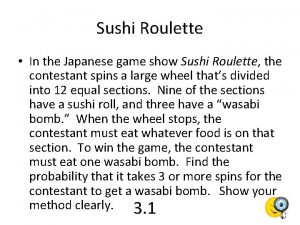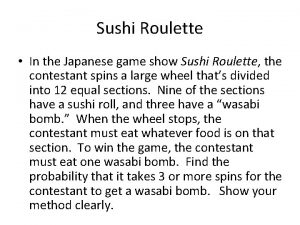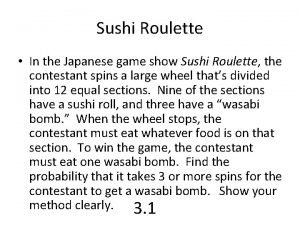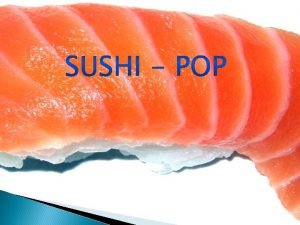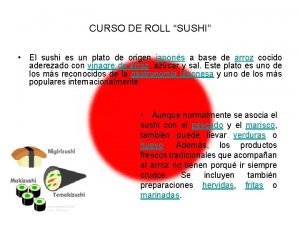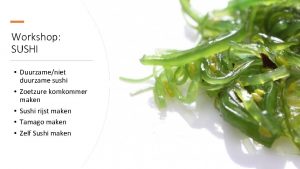The War on Sushi The History and Culture















- Slides: 15

The War on Sushi: The History and Culture of Sushi BY CHLOE MASSENGALE

Introduction § Over the years, sushi has gained popularity as it has globalized from Japan. § This global boom can be dated back to the late 18 th through the early 20 th centuries, as Japanese immigrants settled in larger cities and opened restaurants initially with the Japanese customer base in mind. § But a new emphasis of healthy eating and alternative lifestyle movements helped non-Japanese Americans to pursue those curiosities and embark on a sushi-eating trend…

Thesis Today, the question stands over whether the original Japanese culture, sushi preparation approach, and experience can be found in Americanized sushi places across the United States. Analyzing the culture of sushi, the ways in which it is made, in the past versus today, sushi’s contents, and the different types can provide a further distinction of how the globalization of sushi across cultures and time really started.

History of Sushi Where: Southern China SECOND GENERATION SUSHI (HAN-NARE SUSHI) When: Japan When: 3 rd century B. C. Where: Between 3 rd and 14 th centuries What is it? FIRST GENERATION SUSHI (NARE-SUSHI) ◦ Barrel fermented fish stuffed with rice, eaten with rice, less fermentation time.

History of Sushi cont. THIRD GENERATION: FOURTH GENERATION: Where: Japan Where: Tokyo (Japan) When: 14 th to early 18 th centuries When: 19 th to early 20 th centuries What is it? ◦ Box-pressed cured fish over vinegar-seasoned rice ◦ pre-cured fish over vinegar-seasoned rice, packed with hands.

History of Sushi cont. Fifth Generation Sushi (modern day sushi– ex: King Crab roll, pictured below) o typically raw fish over rice, inside-out roles, or otherwise known as “conveyer belt” sushi o can be prepped within seconds right before you o consists of various meats and types of (raw or cooked) fish, vegetables, sauces/glazes, eggs, cream cheese, rice, tofu, and more

The Globalization of Sushi o Japanese peoples began relocating to America in the 18 th century during the Meiji Revolution, and immigrants continued to settle in places such as Los Angeles, Hawaii, and Sao Paulo in the early twentieth century. o Japanese restaurants began popping up in these areas, run by Japanese peoples and catered for Japanese customers. o “A new emphasis on healthy eating based on vegetables and fish rather than meat, (as well as) Japan’s high media profile in the U. S. following years of rapid economic growth and increasing travel between two countries” were enough to fuel a trend that would only grow in popularity for years to come.

Japan vs. America: The Sushi Debate JAPANESE (TRADITIONAL) SUSHI o Maki sushi, (the traditional Japanese method), consists simply of seaweed, rice, veggies (sometimes), and one type of fish. AMERICANIZED (WESTERN) SUSHI o Sushi is jam-packed and topped with different types of fish, veggies, and “whatever else can fit inside the roll” (Cooper). o typical roll consists of 6 small pieces o orders contain over 8 pieces of a large roll o the passage from novice to professional (can) o typically a few years spent in culinary school, take (up to) ten years to complete (in Japan) as less as 12 weeks in a sushi-chef course, for (Skidelsky). example, or training at a restaurant

Japan vs. America: The Sushi Debate cont o Altering something that is honored and respected as a cultural delicacy, and otherwise holding historical value is seemingly unheard of in Japanese culture. o Sushi has a long history, and the road to becoming a sushi master is challenging. A sushi chef is held at a high respect because of their extensively long, stringent training and masterly performance. o In Japan, a sushi chef’s thorough knowledge of the fish and how to prepare it could prove reason to bash foreigners for their “ignorance of it” (Sakamoto and Allen), their possible lack of skill and eager will to change sushi so representing a lack of appreciation of delicate Japanese flavors, and overall, a lack of respect for a culture. o Because of sushi’s popularity as a snack or fast food in America, accessible between hibachi restaurants, grocery stores, and gas stations, presents the idea that sushi-making is easy, taking little effort to make.

America Dreams of Sushi American’s willingness to play with diverse flavors widens the spectrum of such a previously conditioned dish, making it, one could argue, even more popular in its diversity. “Without a global shipping system and global demand, the markets would disappear” (Mangu-Ward). ◦ The taste for richer fish such as tuna, for example, arrived early on with American troops after World War II, who “introduced enthusiastic red meat eating to a previously ascetic people” (Salvaggio). Most traditional chefs (then) looked down on tuna, which had before been used primarily as cat food and dispersed on the fields for fertilizer. ◦ The most prized sushi today consists of fatty tuna from the belly of the fish, or Toro. The need for tuna sparked intense bidding wars in Japan’s seafood markets (Mangu-Ward), and such demand for various items only increases seller’s profits. It’s not just one type of fish and some rice anymore, and I think it’s safe to say that tuna and avocado rolls probably taste a lot better than a barrel of semi-rotten whitefish packed with rice.

Sushi Anytime: Making it at Home One of the other wonderful innovations of new-wave sushi-making is that you can make it at home. In order to make sushi at home, you need a variety of tools, fish, rice, and specific ingredients pertinent for different types of sushi. Maki-zushi (sushi) Preparation Ingredients: o Nori seaweed wrap o Japanese rice wine (essential for sushi rice taste) o Kewpie Japanese mayonnaise o Pickled ginger (to cleanse the palate) o Soy sauce o Crab meat (real or imitation) o Toasted sesame seeds o Kombu kelp seaweed (used to flavor sushi rice during cooking) o Vegetables (carrots, cucumbers, or others you desire) Tools: o Rice cooker o Sushi-grade knives o Chef’s knife o Fish knife (the longer, more slim blade, the better) o Vegetable knife o Rice rolling mat o Large mixing bowl o Rice paddle or wooden spoon o Small bowls/plates to place ingredients on o Bowl or colander for washing rice and vegetables o Dish cloths to wipe hands and utensils

Conclusion Embracing a culture through its regional practices, art, and especially its food is something valuable. Those things define history, and without that knowledge, we lose pieces of time. Sushi originated in a country that thrives on its culture, growing through people that got by on pickled fish and rice in a time that lacked better options. But that society grew, and others grew around it, accustoming to each other’s’ tastes and ways of life. Whether Western sushi interrupts the cultural impact and meaning of traditional sushi or not, people are still eating it. People love sushi, in all the various ways it can be prepared.

Questions?

List of Illustrations History of Sushi Slides (Images) First–fourth generation sushi: §http: //firstwefeast. com/eat/2015/02/illustrated-history-of-sushi Fifth generation sushi: §http: //www. restaurantnewsrelease. com/tag/kona-grill/ Sushi Anytime: Make it at Home Slide (Images) §http: //www. pbs. org/food/fresh-tastes/how-to-make-sushi-with-step-by-step-breakdown/

Works Cited Mangu-Ward, Katherine. “The Day of the Flying Fish. ” Reason 39. 6 (2007): n. pag. Academic Search Complete. Web. 8 Apr. 2016. Sakamoto, Rumi, and Matthew Allen. "There's Something Fishy About That Sushi: How Japan Interprets the Global Sushi Boom. " Japan Forum 23. 1 (2011): 99 -121. Academic Search Complete. Web. 26 Feb. 2016. Salvaggio, Eryk. “On Eating Foreign Sushi in Japan. ” This Japanese Life. Wordpress. com, 2013. Web. 9 Apr. 2016. Wei, Clarissa. “An Illustrated History of Sushi. ” First We Feast. Complex Media. Web. 6 Apr. 2016.
 History of sushi
History of sushi In the japanese game show sushi roulette
In the japanese game show sushi roulette Russian roulette game show
Russian roulette game show Sushi suzuki
Sushi suzuki Sushi roulette
Sushi roulette Prepare a service blueprint for 100 yen sushi
Prepare a service blueprint for 100 yen sushi Sushi lyrics von wegen lisbeth
Sushi lyrics von wegen lisbeth East asia & sushi
East asia & sushi Sushi pop it
Sushi pop it New service development in service marketing
New service development in service marketing Sap s%2f4 hana
Sap s%2f4 hana Cuanto cuesta una franquicia de sandwich qbano
Cuanto cuesta una franquicia de sandwich qbano Material culture example
Material culture example Continuous culture and batch culture
Continuous culture and batch culture American culture vs indian culture
American culture vs indian culture Stab and stroke culture
Stab and stroke culture

